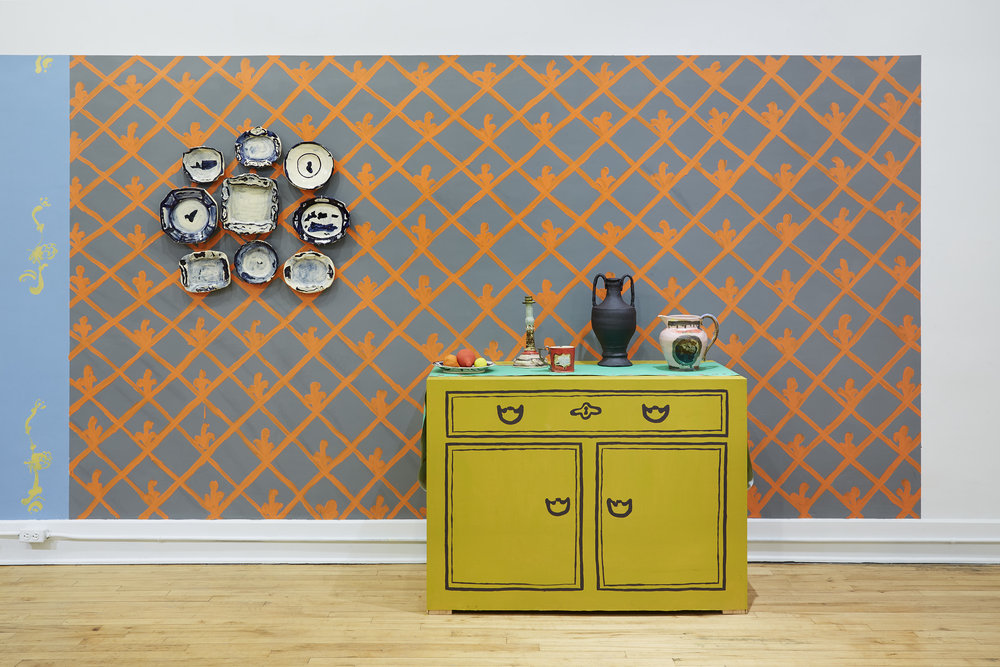Ginny Sims: No Creature Loves an Empty Space
Review by M. J. Gette
Lacuna Gallery
Mar 9–31, 2018

—A FABRICATION OF HEIRLOOMS SPEAKING UP, EAVESDROPPINGS IN/AROUND THE EXHIBITION—
Two households, both alike—on a ship at sea; a tempestuous noise—in sooth, I have much ado to know myself—in the division of a kingdom—2
OVERTURE:
A“sad kitchen” of intentional brushstrokes; tea sets; storied country figurines; color to modernize and brighten otherwise dark legacies; pictoral narratives; clouded emblems—raises questions about the life of objects beyond geographic and temporal origins;
Origins specifically of potters in 17th century Staffordshire, England;
A creature who loves empty space finds itself alone;
A pot calling a kettle black finds itself on American soil;
Whose heirlooms are these and what are they doing here?
SCENE I: [visitor at the gallery]:
“…if the room is a performance of history, a critique or neither—an enabler?… what to do with a whole room; a whole history of rooms…a whole American history;
an American’s distaste for taking tea; an American disdain for its colonial root; only to reproduce its condition / brightly?
…funny these revolutionaries (c. 1773) called themselves Whigs—in disguise as Mohawks—3
As they tossed tea from the harbors of the East India Trading Company
to assert themselves as Real Americans…as duly represented… Parliamentary escape hatches …identified with the root of the land, its people…only to reprise the tune they wanted to escape: let’s play pretend, let’s build a fort, this land is your land…”
[projecting voices unto figurines, handmade objects who]:
“…trace this trade route…” “…how did we get here…” “…a struggle…”
“…push on the space that might glaze them into sales…”
“…in the form of human figures in conversation on a table…”
“…wear their glaze and function through narratives; voicings…”
“…their collection, in rooms, protests the notion of replica, of repetitions—a bargain…”
SCENE 2: [the artist statement]:
“…what it means to be an object…past ceramic traditions were structured by forgotten, implied and traumatized senses of self, family and community.”
“…reconstructions follow this trail of objects to see how they pertain to our current ways of living.”
“…inhabit their surroundings with meaning…their surroundings project meaning onto them.”
“…infuse the everyday with memory…”
SCENE 3: [visitors, in a circle with the artist]:
“…could this have happened in another time/place?…”
“…on the shores of the Thirteen Colonies?…”
“…its evocations, its arrangement…”
“…might it resonate more deeply in a place where this history—of tea sets, porcelain trade, assertion of independence from foreign exports and government—is more immediately recognized than in the midwest, which was not even a territory until the 1800s…”
“… and so what did they know of tea?…”
“…ubiquitous shapes in a messy composition…” “…versus the certainty of seasons and cycles” “…without the pressure…”
“…of novelty” “…props in a theater…”
[who responds]:
“…liking the idea of making it mine, putting everything through my filter…”
“…craving looseness…”
“…the space between things…” “…a little breathing room” “…the forgiveness of spaces…”
“…at a time when potters were trying to figure out how to manufacture meaning”
[and they respond in kind]:
“…craving more wallpaper…”
“…more…” “…is that a Madonna on the wall?”
SCENE 4: [visitors among each other, post-exhibition]:
[over email]:
“…you know how a garment takes on your shape over time?…”
“…in 19th c. Britain, when people pawned their coats, ‘memories’—what bore traces of the people in the fabric—were a ‘fault’ from the point of view of resale, of the commodity, which, remember, has no weight, length, etc. ‘Memories’ were an intrusion of materiality into what is ideally immaterial, virginal…”
[over gchat]:
“…if this hand-me-down quality is essential in recognizing a thing for what it is—heirloom of an elsewhere…recursive ghost…Made in [_______]…”
“… not as raw material for creating something new, improved, and reproducible…”
“…the “unfinished” quality of something, or its “previously worn” evocations become vital sites—of power and even intimacy…”
“…antiques—wrinkled and unsaleable…”
“…because it has “sentimental value”…” “…the handmade has been touched…”
“…tis a dark cobalt wash… over creamware…” “…becomes Blue Ware; Flow Blue…”
“…in its engine-turning lathes; salt-glazed…”
“…remnants remain of 3D silhouettes…black fruit in black bowls…”
“…a neon kitchen unbrightens by facts…”
[in the car, over dinner]:
“…to see the whole room repopulated with furniture from the period, fireplaces, maybe a chandelier…”
“…are they for sale?…I wanted them to be priced according to their inflation rates from when they might have been in vogue four centuries ago…”
“…the abstract quality of the brushstrokes as a purposeful undoing, ‘unlearning,’ she said…”
“…how artists have been taught to reproduce an object 100 times before it might break out of its mold…”
“…no creature loves an empty space…”
“…except for a very European hard-on for blank slates, virginity, terra nullius”
“…they felt alive, to me, the colors felt alive…”
“…I wanted to drink from the pitcher, the pink one with the drips of light grey…”
“…the deeper smudges of commemorative plates on the wall reminded me of the ones my Mom has…”
“…always in process—not progress—”
“…all work has a maker, whose labor can’t be valued in terms of inoperable contexts”
“…who ever reaches their ambitions / alone?” “…it takes a village.”
